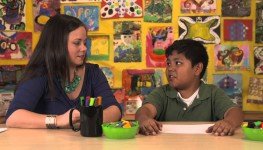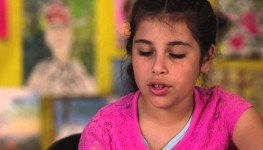Academics
Careers

Does your 3rd grader multiply and divide within 100?

Does your 3rd grader understand what division means?

Can your 3rd grader do word problems with multiplication and division?
What Your Child Will Learn
Round whole numbers to the nearest 10 or 100 (3.NBT.1)
Add and subtract within 1000 (3.NBT.2)
Multiply one digit numbers by multiples of 10. (3.NBT.3)
Standard What Does It Mean?
What Does It Look Like?
Lesson Set
Lesson Set
Lesson Set
Vocabulary
Place value: The location of a digit in a number
Value: The value of a digit based on its place value
Product: the result of multiplication
Factor: a number that is multiplied by another number to get a product
Multiple: a product of two whole numbers
Addition: To join two or more groups. 2 + 3 = 5
Addend: A number that is added to another in an addition problem.
In 2 + 3 = 5, 2 and 3 are addends.
Sum: The answer to an addition problem. In 2 + 3 = 5, 5 it is the sum.
Subtraction: To find the difference when two groups are compared or to find out how many are left when items are taken away from a group.
Difference: The answer to a subtraction problem. In 8 – 3 = 5, 5 is the difference.
Activities at Home
Roll 2 number cubes. Find the products of the factors.
Locate numbers in catalogs or newspapers, then practice rounding them to the nearest tens and hundreds.
Roll a number cube and practice multiplying that number by ten. After mastery, try with two number cubes.
Practice adding and subtracting three-digit numbers.
Show your child various numbers of dimes and have your child practice counting the amount of money (4 dimes x 10 cents = 40 cents).
Learning Links
What Your Child Will Learn
Standard
Understand the meaning of multiplication (3.OA.1)
Understand the meaning of division (3.OA.2)
Solve word problems using multiplication and division (3.OA.3)
Determine the unknown whole number in a multiplication or division problem
(? X 8 = 24) (3.OA.4)
Understand the properties of multiplication (3.OA.5)
Understand division as an unknown factor problem (3.OA.6)
Fluently multiply and divide within 100 (3.OA.7)
Solve word problems using addition, subtraction, multiplication and/or division (3.OA.8)
Identify and explain arithmetic patterns (3.OA.9)
What Does It Look Like?
What Does It Mean?
Vocabulary
Division: to make equal groups
Dividend: a number that is divided by another number
Array: an arrangement that shows objects in columns and rows
Equation: a mathematical statement containing an equal sign, to show that two expressions are equalunknown
Product: the result of multiplication
Grouping: dividing things into equal groups (sets)
Quotient: the number, not including the remainder, that results from dividing
Partition: to divide into parts
Multiplication: an operation on two numbers to find their product. It can be thought of as repeated addition.
Multiple: a product of two whole numbers
Remainder: the amount left over when a whole number cannot be divided into equal whole numbers
Factor: a number that is multiplied by another number to get a product
Subtraction: To find the difference when two groups are compared or to find out how many are left when items are taken away from a group.
Addition: To join two or more groups. 2 + 3 = 5
Addend: A number that is added to another in an addition problem.
In 2 + 3 = 5, 2 and 3 are addends.
Sum: The answer to an addition problem. In 2 + 3 = 5, 5 it is the sum.
Difference: The answer to a subtraction problem. In 8 – 3 = 5, 5 is the difference.
Estimation: a number close to an exact amount
Mental Computation: the calculation of something mentally
Activities at Home
Make arrays out of household items (e.g., pennies, beans, blocks)
Select multiplication or division facts to illustrate or write a word problem.
Hunt for multiple sets of objects in the home. Use repeated addition and multiplication to find the totals.
Sort coins according to type, count the number of coins and then multiply to find the total value of pennies (x 1), nickels (x 5), dimes (x 10) and quarters (x 25).
Roll 2 number cubes. Find the products of the factors.
Count quantities of items by 2’s, 3’s, 5’s, and 10’s.
Roll 2 number cubes to determine the factors. Make an array to find the product.
Use a calculator to solve word problems using multiplication and division. For example, Callie wants to buy 20 apples that cost $ .19 each. What is the total cost of her purchase? Michael has 332 quarters. He wants to put them into groups of 4. How many groups will he make?
Act out division problems with counters. For example, Brad has 12 rabbits. He puts the same number of rabbits into each of 4 cages. How many rabbits does Brad put in each cage?
Roll 2 number cubes and write the fact families. For example, for rolls of 4 and 6, write: 4 X 6 = 24, 6 X 4 = 24, 24 ¸ 6 = 4, 24 ¸ 4 = 6.
Ask your student to find the missing factor. For example, 5 X what number? = 75?
Learning Links
Basic Fact Practice
What Your Child Will Learn
Tell and write time to the nearest minute and understand elapsed time (3.MD.1)
Measure and estimate liquid volumes (3.MD.2)
Create picture graphs and bar graphs to represent data (3.MD.3)
Measure with a ruler to the nearest ¼ inch (3.MD.4)
Understand area. (3.MD.5)
Measure the area by counting unit squares. (3.MD.6)
Use multiplication to find area of rectangles. (3.MD.7)
Solve problems that use perimeter. (3.MD.8)
Standard What Does It Look Like?
What Does It Mean?
Lesson Set 1
Lesson Set 2
Lesson Set 1
Lesson Set 2
Lesson Set 1
Lesson Set 2
Lesson Set
Lesson Set
Lesson Set
Lesson Set
Vocabulary
Analog Clock: A clock that shows time by moving hands around a circle for hours,minutes, and sometimes seconds
Area: The number of square units needed to cover a flat surface.
Digital Clock: A clock that shows time to the minute using digits
Distance: The amount of space between two given points
Elapsed Time: A measurement of the amount of time from one event to another
Estimate: A guess or rough calculation of worth, quantity, or size
Mass: A measure of how much matter is in an object.
Measure: Use of standard units to find out size or quantity in regard to length, height, area, mass, volume, time, perimeter
Perimeter: The distance around a figure
Scaled Bar Graph: A graph that uses bars to show data
Scaled Pictograph: A graph that uses pictures to show data
Standard Unit: A traditional unit of measurement from the metric or customary system. Examples include inches, meters, pounds, etc.
Time: Seconds, minutes, hours, days, months, years, and so on. Time is shown on a clock or calendar.
Volume: The amount of space occupied by an object
Activities at Home
Share and discuss tables and graphs found in newspapers and magazines.
Conduct a survey among family members or friends and construct a bar graph or pictograph.
Make a physical pictograph using real objects (e.g., fruits, vegetables, cereal, kitchen tools). Record the graph on paper. Change the scale to create a new pictograph.
Make records of important times of the day (wake-up, dinner, going to school, getting home from school, etc.) and practice telling how long between activities.
Calculate elapsed time by finding out how long it takes to complete daily activities (soccer practice, homework, take a shower, etc.)
Measure the perimeter and area of the rooms in your home to determine which rooms are the smallest and largest.
Use grid paper to make rectangles with the same perimeters. Determine the area of each rectangle.
Fill a small box with blocks (e.g., sugar cubes) to determine its volume. Brainstorm multiple strategies to determine the volume.
Learning Links
What Your Child Will Learn
Understand the meaning of a fraction. (3.NF.1)
Place a fraction on a number line (3.NF.2)
Understand equivalent fractions (3.NF.3)
What Does It Look Like?
What Does It Mean?
Lesson Set
Lesson Set 1
Lesson Set 2
Lesson Set 3
Vocabulary
Denominator: the bottom number in a fraction. It tells how many equal parts the set or whole has been divided into
Equivalent Fractions: two or more fractions that name the same amount
Fraction: a number that names part of a whole or part of a group
Greatest: the largest in a group
Least: the smallest in a group
Number Line: a line with equally spaced tick marks named by numbers
Numerator: the top number in a fraction. It tells how many of the equal parts of the whole or group are being considered
Order: arrangement according to size, amount, or value
Activities at Home
Go on a fraction hunt! Look for household items that are divided into equal parts (fractions of a whole and fractions of a set). Record the fractions.
Roll number cubes to make fractions. Draw pictures of the fractions you make. Place the fractions you've made in order on a number line.
Identify fractions at meal times. For example, you ate 1/2 of an apple, 3/4 stalk of celery, 1 whole tuna sandwich, and 2/3 of a glass of milk.
Practice making equivalent fractions.
Plot fractions on a number line.
Learning Links
What Your Child Will Learn
Understand the attributes of quadrilaterals. (3.G.1)
Divide shapes into parts with equal areas. (3.G.2)
Standard What Does It Look Like?
What Does It Mean?
Vocabulary
Congruent: Shapes that have the same size and shape
Parallelogram: A quadrilateral with two pairs of parallel sides and two pairs of equal sides
Polygon: A closed, 2-D figure with straight lines
Quadrilateral: A polygon with four sides
Rectangle: A 2-D figure with 4 sides and 4 right angles, opposite sides are parallel
Rhombus: A 2-D figure with 4 equal sides and 4 angles (not necessarily equal), opposite sides are parallel
Square: A 2-D figure with 4 equal sides and 4 right angle
Fraction: A number that names part of a whole
Trapezoid: A 2-D figure that has 4 sides and 4 angles, one pair of sides is parallel
Right angle: An angle that forms a square corner
Activities at Home
Use grid paper to create congruent shapes.
Identify, describe, and classify different household objects as solid figures.
Identify angles that are less than, equal to and greater than right angles.
Use tangrams to make plane figures.
Cut pieces of yarn to make line segments. Measure each segment in inches (to the nearest quarter inch) and centimeters.
Go stargazing and make imaginary line segments by connecting the stars (points). Create geometric shapes.
Go on a shape hunt! Look for geometric shapes in your home and community. Create a chart to show your findings.
Learning Links